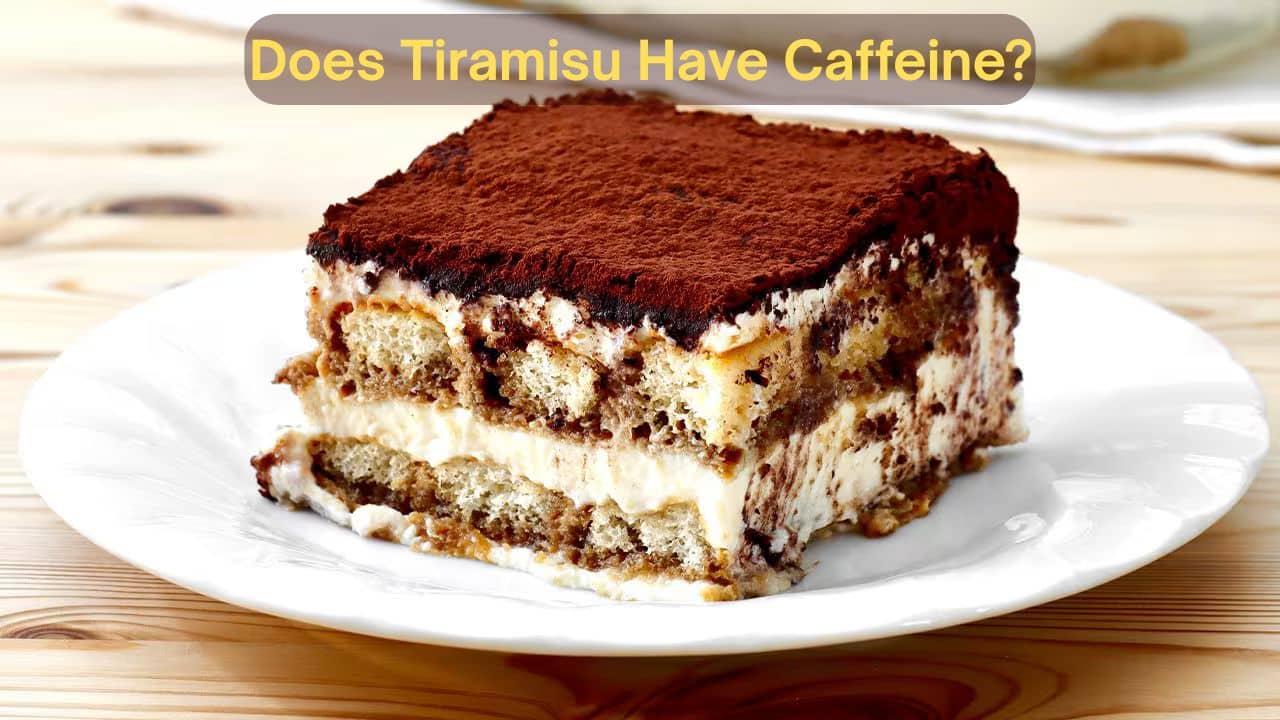Written By: Sherry Harris
Tiramisu originated in Italy in the 1960s, with many regions claiming the honor. The name literally means “pick me up” — which might hint at more than just the taste. The combination of sugar, cream, and coffee makes it an energy-booster, and yes, caffeine might be a part of that story.
Table of Contents
What is Tiramisu?
Tiramisu is that creamy, dreamy Italian dessert that feels like a hug for your taste buds. With layers of soft ladyfingers soaked in coffee, topped with a rich mascarpone mixture, and dusted with cocoa, it’s hard not to love. But beyond the flavor, one question often comes up — does tiramisu have caffeine?
Does Tiramisu Have Caffeine?
Yes, traditional tiramisu contains caffeine due to the use of espresso or strong coffee soaked into the ladyfingers. A small amount of caffeine also comes from the cocoa powder dusted on top, although this contribution is minimal. On average, a single serving of tiramisu can contain between 40 to 65 mg of caffeine, depending on how much coffee and cocoa are used.
While this amount is lower than what’s found in a typical cup of coffee, it can still affect individuals who are sensitive to caffeine. If you’re avoiding caffeine for health or personal reasons, it’s best to check the ingredients or opt for a caffeine-free version made with decaf coffee or coffee alternatives.
Where the Caffeine Comes From
Caffeine in tiramisu primarily comes from the espresso or coffee used to soak the ladyfingers. A small amount also comes from the cocoa powder sprinkled on top. Combined, these sources contribute to the overall caffeine in a typical slice. The caffeine level can vary depending on the type and amount of coffee used.
Average Caffeine Amount Per Serving
The caffeine content in a standard serving of tiramisu usually falls between 40 to 65 mg. This is equivalent to what you’d find in a can of cola or a weak cup of tea. The actual amount can differ depending on the espresso concentration and serving size. It’s not negligible but still far less than a cup of brewed coffee.
| Serving Size | Estimated Caffeine |
|---|---|
| 3.5 oz (100g) | 40–65 mg |
That’s about the same as a can of soda or weak cup of tea.
Caffeine Comparison With Coffee and Tea
Compared to beverages, tiramisu contains moderate caffeine. A regular 8-ounce cup of coffee has around 95 mg of caffeine, whereas black tea contains about 47 mg. A slice of tiramisu usually falls somewhere in between, making it a mild source of caffeine. It’s unlikely to cause the same stimulant effects as coffee.
| Beverage/Dessert | Caffeine (Approx.) |
|---|---|
| 8 oz Coffee | 95 mg |
| 8 oz Black Tea | 47 mg |
| Slice of Tiramisu | 40–65 mg |
| Cola (12 oz) | 34 mg |
Key Ingredients in Tiramisu
Coffee or Espresso:
Coffee or espresso is a key ingredient that gives tiramisu its signature flavor. Most recipes use strong brewed espresso to soak the ladyfingers, which contributes a noticeable caffeine content. The espresso not only enhances the taste but also adds depth and aroma to the dessert. This is the primary source of caffeine in tiramisu.
Ladyfingers (Savoiardi):
Ladyfingers are light, sponge-like biscuits that serve as the base of tiramisu. These biscuits absorb the coffee or espresso, acting as a vessel for the caffeine. On their own, ladyfingers don’t contain caffeine. However, once soaked, they become a major source of the dessert’s caffeine content.
Cheese and Cream:
The mascarpone layer adds a creamy, rich texture to tiramisu without any caffeine. It is often mixed with whipped cream or egg yolks to create a smooth filling. This component balances the bitterness of the coffee and the sweetness of the sugar. It’s entirely caffeine-free and essential for the dessert’s structure.
Cocoa Powder
A light dusting of cocoa powder is typically added on top of tiramisu. Cocoa contains a small amount of caffeine, but the quantity used in tiramisu is minimal. While it adds a chocolaty finish, it contributes only a negligible amount to the dessert’s total caffeine. For most people, this isn’t enough to cause any noticeable effect.
Alcohol (Optional):
Some tiramisu recipes include alcohol such as rum or coffee liqueur. While these enhance the dessert’s flavor, they do not contribute to caffeine levels. The type and amount of alcohol used can vary depending on the recipe. Alcohol is optional and can be omitted for a non-alcoholic version.
Nutritional Breakdown of Tiramisu
A typical slice of tiramisu contains between 450 to 550 calories, depending on the ingredients. It’s high in fat due to the mascarpone and cream, and also contains a significant amount of sugar. While delicious, it’s best enjoyed in moderation. The caffeine content, usually 40–65 mg, is moderate compared to other foods.
| Nutrition Facts | Amount per Serving |
|---|---|
| Calories | 450–550 kcal |
| Total Fat | 30–35g |
| Carbs | 35–45g |
| Sugar | 20–30g |
| Protein | 6–8g |
| Caffeine | 40–65 mg |
Note: These values can vary based on the recipe.
Does All Tiramisu Contain Caffeine?
Traditional Recipes vs Modern Twists
Traditional tiramisu recipes almost always contain caffeine due to their use of espresso. However, modern versions sometimes use decaf coffee or other non-caffeinated liquids. These variations are ideal for people who are sensitive to caffeine. You can often find recipes tailored to dietary preferences or restrictions.
Store-Bought and Restaurant Variations
Store-bought tiramisu usually contains caffeine unless labeled otherwise. Restaurants may not disclose whether the coffee used is caffeinated or decaf. If you’re sensitive to caffeine, it’s best to ask before ordering. Packaging for commercial tiramisu sometimes lists coffee or caffeine as an ingredient.
How to Make Caffeine-Free Tiramisu
Substitutes for Coffee or Espresso
Decaf coffee is the most straightforward substitute for regular espresso in tiramisu. It provides a similar flavor profile without the caffeine. For caffeine-free options, some people use warm milk with vanilla extract or hot chocolate. These substitutes make tiramisu suitable for kids and caffeine-sensitive individuals.
Caffeine-Free Cocoa Options
Caffeine-free cocoa powder is available from some specialty brands. Another alternative is carob powder, which mimics the flavor of chocolate without the caffeine. These options let you keep the traditional look and taste of tiramisu. You won’t notice much difference in flavor with these swaps.
Recipe Ideas for Kids and Sensitive Groups
A kid-friendly tiramisu might use milk instead of coffee and vanilla pudding instead of mascarpone. Whipped cream and fruit can be added for flavor and decoration. These variations ensure there’s no caffeine involved. It’s a great way to enjoy the dessert without any health concerns.
Is Caffeine in Tiramisu Safe for Everyone?
Children and Teens
Due to caffeine and sometimes alcohol, traditional tiramisu is not ideal for young children. Even small amounts of caffeine can affect kids more than adults. Modified versions without caffeine or alcohol are safer alternatives. Parents should check ingredients or make their own kid-friendly versions.
Pregnant Women
Pregnant women are advised to limit caffeine to about 200 mg per day. A single serving of tiramisu generally falls well below this limit. However, if other sources of caffeine are consumed, it’s important to keep track. Opting for decaf versions can reduce any potential risk.
People Sensitive to Caffeine
Some individuals experience jitteriness or insomnia even from small amounts of caffeine. These people should avoid traditional tiramisu or look for decaf alternatives. Caffeine-free recipes are widely available and easy to prepare. Always check labels or ask about ingredients when eating out.
Daily Intake of Tiramisu
Tiramisu is a rich dessert high in sugar, fat, and calories, so it’s best enjoyed in moderation. For most adults, one standard slice (about 3.5 to 4 ounces) is a reasonable serving size, which typically provides 450–550 calories and 40–65 mg of caffeine. Consuming more than one serving per day regularly can contribute to excessive calorie and sugar intake, especially if paired with other desserts or caffeinated foods.
Health professionals generally recommend limiting high-sugar desserts to occasional treats rather than daily staples. If you’re monitoring your caffeine or calorie intake — such as during pregnancy, weight management, or for health conditions like diabetes — stick to a single slice or opt for lighter, decaf versions. Balancing tiramisu with a nutrient-rich diet ensures you can enjoy it without negative health impacts.
Conclusion
So, does tiramisu have caffeine? Yep, most versions do — mainly from coffee and a dash from cocoa powder. But don’t worry, it’s not as strong as a cup of joe. You can also tweak the recipe to make it caffeine-free and family-friendly.
If you’re sensitive to stimulants or just want to avoid caffeine late at night, just ask or make your own version. Either way, tiramisu is still one of the most beloved desserts — with or without the buzz.
1. Does all tiramisu contain caffeine?
Not all tiramisu contains caffeine, but most traditional recipes do. The caffeine mainly comes from espresso used to soak the ladyfingers and a small amount from the cocoa powder dusted on top. Some modern recipes use decaf coffee or alternative liquids to eliminate caffeine. If you’re sensitive, it’s best to ask or check the ingredients before eating.
2. Can I eat tiramisu if I’m pregnant?
Yes, you can eat tiramisu while pregnant, but in moderation. A typical slice contains about 40–65 mg of caffeine, which is within the 200 mg daily limit recommended for pregnant women. However, some versions also contain raw eggs or alcohol, which should be avoided or substituted. Opting for homemade or clearly labeled options helps ensure safety.
3. Is there a caffeine-free version of tiramisu?
Yes, caffeine-free tiramisu is easy to make using decaf coffee or other substitutes like warm milk or hot chocolate. These versions maintain the dessert’s creamy texture and layered look without including stimulants. Carob powder or caffeine-free cocoa can replace traditional cocoa powder. This makes the dessert suitable for kids, pregnant women, or those avoiding caffeine.
4. How much caffeine is in one slice of tiramisu?
One standard slice of tiramisu generally contains between 40 to 65 milligrams of caffeine. This amount varies based on how strong the coffee is and how much is used in the recipe. It’s comparable to a soft drink or mild tea, but much less than a regular cup of coffee. People who are highly sensitive may still feel mild effects.
5. Can children eat tiramisu?
Traditional tiramisu is not recommended for children because of the caffeine and potential alcohol content. Even small amounts of caffeine can affect a child’s sleep and behavior. However, caffeine-free and alcohol-free versions are safe and commonly made for family-friendly occasions. Always check the ingredients or make your own to control what’s included.

